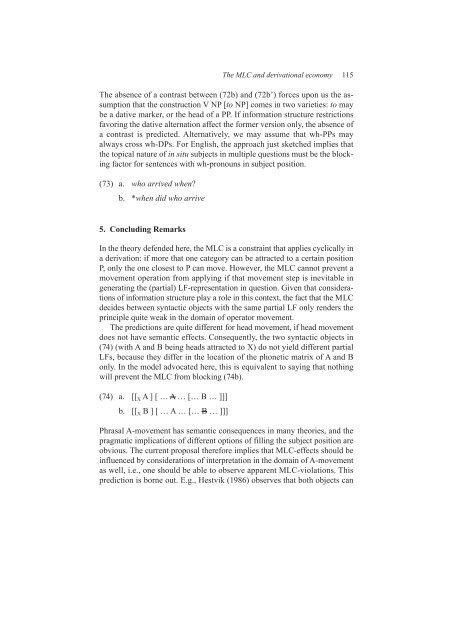Minimality Effects in Syntax · The MLC and Derivational Economy ...
Minimality Effects in Syntax · The MLC and Derivational Economy ...
Minimality Effects in Syntax · The MLC and Derivational Economy ...
You also want an ePaper? Increase the reach of your titles
YUMPU automatically turns print PDFs into web optimized ePapers that Google loves.
<strong>The</strong> absence of a contrast between (72b) <strong>and</strong> (72b’) forces upon us the assumption<br />
that the construction V NP [to NP] comes <strong>in</strong> two varieties: to may<br />
be a dative marker, or the head of a PP. If <strong>in</strong>formation structure restrictions<br />
favor<strong>in</strong>g the dative alternation affect the former version only, the absence of<br />
a contrast is predicted. Alternatively, we may assume that wh-PPs may<br />
always cross wh-DPs. For English, the approach just sketched implies that<br />
the topical nature of <strong>in</strong> situ subjects <strong>in</strong> multiple questions must be the block<strong>in</strong>g<br />
factor for sentences with wh-pronouns <strong>in</strong> subject position.<br />
(73) a. who arrived when?<br />
b.*when did who arrive<br />
5. Conclud<strong>in</strong>g Remarks<br />
In the theory defended here, the <strong>MLC</strong> is a constra<strong>in</strong>t that applies cyclically <strong>in</strong><br />
a derivation: if more that one category can be attracted to a certa<strong>in</strong> position<br />
P, only the one closest to P can move. However, the <strong>MLC</strong> cannot prevent a<br />
movement operation from apply<strong>in</strong>g if that movement step is <strong>in</strong>evitable <strong>in</strong><br />
generat<strong>in</strong>g the (partial) LF-representation <strong>in</strong> question. Given that considerations<br />
of <strong>in</strong>formation structure play a role <strong>in</strong> this context, the fact that the <strong>MLC</strong><br />
decides between syntactic objects with the same partial LF only renders the<br />
pr<strong>in</strong>ciple quite weak <strong>in</strong> the doma<strong>in</strong> of operator movement.<br />
<strong>The</strong> predictions are quite different for head movement, if head movement<br />
does not have semantic effects. Consequently, the two syntactic objects <strong>in</strong><br />
(74) (with A <strong>and</strong> B be<strong>in</strong>g heads attracted to X) do not yield different partial<br />
LFs, because they differ <strong>in</strong> the location of the phonetic matrix of A <strong>and</strong> B<br />
only. In the model advocated here, this is equivalent to say<strong>in</strong>g that noth<strong>in</strong>g<br />
will prevent the <strong>MLC</strong> from block<strong>in</strong>g (74b).<br />
(74) a.[[ X A ] [ … A … [… B … ]]]<br />
b.[[ X B ] [ … A … [… B … ]]]<br />
<strong>The</strong> <strong>MLC</strong> <strong>and</strong> derivational economy 115<br />
Phrasal A-movement has semantic consequences <strong>in</strong> many theories, <strong>and</strong> the<br />
pragmatic implications of different options of fill<strong>in</strong>g the subject position are<br />
obvious. <strong>The</strong> current proposal therefore implies that <strong>MLC</strong>-effects should be<br />
<strong>in</strong>fluenced by considerations of <strong>in</strong>terpretation <strong>in</strong> the doma<strong>in</strong> of A-movement<br />
as well, i.e., one should be able to observe apparent <strong>MLC</strong>-violations. This<br />
prediction is borne out. E.g., Hestvik (1986) observes that both objects can
















